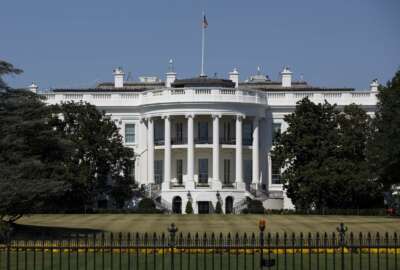
Planning still underway for presidential transition
With a national election coming in November, the General Services Administration has been gearing up for presidential transition.
Best listening experience is on Chrome, Firefox or Safari. Subscribe to Federal Drive’s daily audio interviews on Apple Podcasts or PodcastOne.
With a national election coming in November, the General Services Administration has been gearing up for presidential transition. It’s required to by law, which requires transition planning even if an incumbent is re-elected. For a look inside all of the planning, Federal Drive with Tom Temin spoke with the director of the center for presidential transition at the Partnership for Public Service, Dave Marchick. Read more here.
Interview transcript:
Tom Temin: Mr. Marchick, good to have you on.
Dave Marchick: Thanks for having me.
Tom Temin: Well, what do we need to know about transition? If I’m, say a federal manager, and I’m working, in some cases, loving it or maybe hating itm varies under current administration. What do I care about transition at this point for?
Dave Marchick: Well, it’s a big deal. That’s what you should care about, and that you should expect change regardless of who wins. So if Biden wins, the entire government will change. He has 4000 political appointees to appoint, 1250 of them need to be confirmed. He will be supervising a huge federal budget, and there will be significant changes in policy. If Trump is reelected, the data shows that almost half of the top officials, cabinet, deputy secretary and undersecretary leave within six months of a second term. So what federal officials should expect is change regardless of who wins.
Tom Temin: Now there is a pretty elaborate legal process and I guess GSA is the point agency on preparing the government for transition. What happens at this point in the process when there’s still months to go before the election itself?
Dave Marchick: Well, quietly, agencies like GSA, OMB, DOJ and others, have been working for years to prepare for this election. There’s a statute called the Presidential Transition Act, which requires two different organizations, one in the White House and one run by GSA and OMB, to coordinate activities across the government starting six months in advance. And so GSA has a team of people very accomplished, very organized, professional individuals who are preparing for either eventuality a Trump victory or a Biden win. And they provide space, they provide security, they provide computers, they provide a whole suite of services to the candidate that’s challenging the incumbent. And then they provide services to the incumbent in case he wins as well.
Tom Temin: And in their most recent report to Congress, the GSA said that they had already stood up different committees and councils of the political appointees themselves to kind of make sure that things happen as they should.
Dave Marchick: Exactly they have already made space set aside in the Commerce Department and Herbert Hoover building. They’re ready for the Biden team to take that space on September 1, which is right after the second convention. They are ready to provide computers, security, personal devices. And then there’s also lots of coordination across the government with the Secret Service, with Department of Justice with the DNI with lots of different agencies to provide a whole suite of support services for whoever wins the next presidency.
Tom Temin: Now you had high level official positions in the Clinton administration. I guess that might be the first one where everybody had a computer in those days. What’s it like if you are an appointee or acting in a, you know, a policy position, and you know there’s going to be a change in administration. In this case, Al Gore lost the election and George W. Bush was coming in. What’s it like, on the inside when you’re seeing this happening?
Dave Marchick: Well, it’s chaotic. It’s pressure filled, and the stakes are very high. Transitions used to be a four month process. Roosevelt was the last person elected, that had four months. So he was elected in November. He didn’t take office until early March. Now it’s a 77 or 78 day process. And in that time, between the election and the inauguration, there’s just an enormous amount of work that needs to be done. So if you’re an outgoing administration, you’re required to brief the incoming administration, you’re required to prepare the agency, you’re required to brief the incoming secretary and senior officials on what the big issues are, what’s coming down the road, what’s going to hit the fan. And continuity of government is essential. If you’re part of the transition team, then you’re planning for personnel you’re planning for new policies. You’re planning an entire government that can hit the ground running on January 20. So let me ask you a question, so let me quiz you. There are 1250 officials that need to be confirmed by the Senate. The fastest start for any president, any modern president, was President Obama. How many officials do you think he had confirmed on day 100 of those 1250?
Tom Temin: I used to know that number but I think it was golley maybe a couple of hundred, I think is all they had.
Dave Marchick: So he had the best transition ever, and he had 69. And that just shows you the degree of difficulty of getting people in their seats quickly. We have a national interest. To have highly competent, qualified people in these roles quickly, and it just takes time. And that’s why early planning, early preparation is so critical for a quick start.
Tom Temin: And by the way, when you left, did you leave your W-key on your keyboard?
Dave Marchick: Well, actually, I left about a year in advance of the Clinton departure because I was worried about getting a job. I didn’t want to be part of a wave, you know, maybe that was dumb, in hindsight, but I had seven great years, it was a privilege to work in the government, it was a privilege to represent the United States.
Tom Temin: And getting to that issue of how long it does take to fill those jobs. And I would say, regardless of what you think, politically, the Trump administration probably hasn’t been as skillful at it as maybe other administrations and getting all those jobs filled. But an incoming team would, or even a team that’s anticipating winning for example, would have to I imagine have a really good black book of people that wants and start vetting them way in advance. And you almost have to do it in secret so you don’t look like you’re, to use the proverbial Washington phrase, measuring the drapes in the Oval Office?
Dave Marchick: Absolutely. Well, I think that the Times have changed and now we want people to measure the drapes. In fact, the Presidential Transition Act encourages candidates to measure the drapes and encourages both sides to be ready. So what happens is between now and November, whoever is the challenger typically would be putting together that priority positions, putting together slates of potential people, figuring out which committees they need to go through, and figuring out whether there’s going to be any ethics or other betting concerns. They will have all that information ready for the day after the elections. On the day after the election, they need to be ready to have four to 500 people go into the agencies to work with the agencies, figuring out what the issues are, what the priorities are, what the problems are, and report that back to the president elect and to the president elects team. And then in that 78 days, they need to start selecting officials on a very, very rapid basis so that on January 20, they literally have hundreds of people that are ready to start in the government and ready to provide new direction for the country. If Trump wins, they can expect a very significant level of turnover. And so they are planning as well as previous to term presidents have done as well.
Tom Temin: And if you know you’re going to be the Deputy Undersecretary of XYZ or even the Secretary, and you go in, again, regardless of whether it’s a whole new administration, or you’re replacing someone in the incumbent administration, what are the top questions you should ask so that you can know what to prepare for when you do get in there?
Dave Marchick: Well, the first thing that one should do if they want to serve is get their forms ready, or process for getting into the government is not easy. There’s this dreaded form. It’s called the SF-86, which is a security question. It’s 120 or 130 pages of questions. So that takes forever to fill out. And so if you’re really serious about potentially seeking a role in the government, you should start to get your forms and your taxes and all the other materials in order. Then when you go into these roles, you want to find out, what are the big issues? What are the big problems? What’s my President’s priorities for this agency? And then you want to get to know the career officials in that part of the government. The career officials have incredible institutional knowledge, expertise, and they’re the people that implement policy and change. So many administration’s many new political appointees make the mistake of not trusting and not relying on the career officials. And that’s a huge mistake. The new appointees need to work with them need to rely on them and need to benefit from their expertise.
Tom Temin: Dave Marchick is director of the Center for Presidential Transition at the Partnership for Public Service. Thanks so much for joining me.
Dave Marchick: Thanks for having me.
Copyright © 2024 Federal News Network. All rights reserved. This website is not intended for users located within the European Economic Area.
Tom Temin is host of the Federal Drive and has been providing insight on federal technology and management issues for more than 30 years.
Follow @tteminWFED
Related Stories




